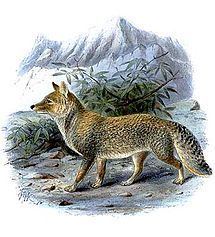Suborder Caniformia Scientific name Caninae Phylum Chordata | Lifespan Red fox: 2 – 4 years | |
 | ||
Subfamily CaninaeG. Fischer de Waldheim, 1817 Height Gray wolf: 80 – 85 cm, Coyote: 58 – 66 cm Gestation period Gray wolf: 62 – 75 days, Coyote: 60 – 63 days Mass Gray wolf: 30 – 80 kg, Coyote: 6.8 – 21 kg Lower classifications Gray wolf, Canis, Coyote, Dhole, Arctic fox | ||
In the history of the carnivores, the family Canidae is represented by the two extinct subfamilies designated as Hesperocyoninae and Borophaginae, and the extant subfamily Caninae. This subfamily includes all living canids and their most recent fossil relatives. Their fossils have been found in Lower Oligocene North America, and they did not spread to Asia until the end of the Miocene, some 7 million to 8 million years ago. Many extinct species of Caninae were endemic to North America, living from 34 million to 11,000 years ago.
Contents
Taxonomy
"Derived characteristics that distinguish the Caninae from other canids include small, simple, well-spaced premolars, a humerus without an entepicondylar foramen, and a metatarsal 1 which is reduced to a proximal rudiment."
Based on genetic assumptions, the present-day, more-basal canids include:
